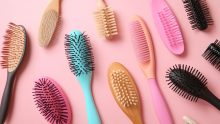Advertising Disclosure
A Few Simple Tips To Naturally Whiten Your Teeth At Home

Everyone wants whiter teeth, well at least 80% of Americans between the ages of 18-49 do. And why not? Pearly whites are statistically proven to make people appear more attractive, successful, wealthy and memorable. It’s no wonder that 6/10 Americans are convinced that having whiter teeth would greatly boost their self confidence and give off an overall better first impression.
In fact, last year alone Americans spent more than $1.4 billion on over the counter teeth whitening products. While the success of the OTC whitening kits, strips and pastes is quite evident, not many of their common side effects are as easy to see. Harmful chemicals like polyethylene glycol, sodium hydroxide, diethanolamine and ammonium hydroxide are known to stimulate enamel erosion, gum damage and potential tooth fracture. Thankfully, there are safer options in the comfort of your own home.
Why Yellow
Enamel, the hard outermost layer of the tooth, is what makes the teeth white. The enamel protects the yellowish brown tissue beneath it, known as dentin. When the enamel is thinned, the dentin is exposed. A wide variety of factors can lead to the thinning and extrinsic staining of the enamel such as gum disease, acidic food, aging, smoking and antibiotics, just to name a few.
Baking Soda and Hydrogen Peroxide
Baking soda is a mild abrasive that has the capacity to gently scrub away existing stains on your teeth (mild being the key word). Many people still subscribe to the old notion that it’s too harsh for sensitive teeth, when in fact it only scores a 7/250 on the RDA scale. The RDA, or relative dentin abrasivity scale, measures how caustic a substance is on the tooth and it’s tooth cutting ability.
That being said, it’s completely safe to mix together a paste of 1 tsp baking soda with a few drops of water and gently brush with it daily.
Hydrogen peroxide is a mild bleaching agent that works wonders on yellowish teeth. While hydrogen peroxide is a bleach and not suggested for long term use, rest assured it’s completely safe considering that most drug store bottles are diluted to only 3%.
So feel free to swish it around your mouth a couple times a week for a brighter smile. Or even better, create a hydrogen peroxide and baking soda paste as a whitening treatment. Mix together 1 tbsp of baking soda with 2 tbsp of hydrogen peroxide and brush with the paste for 2 minutes, twice a day, for about a week.
Oil Pulling
The Ayurvedic method of oil pulling, also known as kavala (gargling) or gandusha (holding fluid in the mouth), dates back over 3000 years. This process involves washing your mouth with oil to “pull” the bacteria, dirt and debris out of your mouth, thus removing the plaque buildup that generates a yellow hue.
Coconut oil is a favorite, but sunflower, sesame and olive oil can all be used as well. Draw 1 tbsp of your chosen oil and swish with it for 10-20 minutes. Don’t let the oil touch the back of your throat nor swallow it as it’s filled with the bacteria and germs pulled from your mouth. Brush after the pull to ensure that any leftover toxins are completely removed.
Essential Oil Whitening Paste
Mix your own toothpaste with equal parts peppermint oil, coconut oil, cinnamon bark oil, spearmint essential oil and baking soda. The lauric acid in the coconut oil combats the golden canary causing bacteria found in plaque while the mint provides a cooling, minty fresh flavor.
Foods
People love to tell you what you shouldn’t do. Experts love to tell you all the forbidden foods to ditch for whiter teeth such as coffee, wine, chocolate, citrus, berries and so on. However since the number one no-no (coffee) is something I refuse to live without, I’d rather look on the bright side, and mention all the foods you should be having.
Crunchy vegetables like broccoli, cauliflower and other coarse vegetables that are high in fiber increase saliva production to erase stains and scrape away at the yellow. Nuts and seeds are also valuable exfoliants. Dairy products such as cheese, yogurt and milk contain lactic acid which both strengthens and brightens the tooth enamel.
Certain fruits have proven quite beneficial in whitening as well. The bromelain enzyme in pineapple eliminates surface stains while malic acid in apples is known to boost saliva and aid in plaque removal. The banana, rich in magnesium and potassium, repairs not only tooth enamel but can also naturally treat acne, psoriasis and wrinkles.
Want a quick boost? Peel a banana and rub the peel all over your teeth for 2 minutes. Brush away any excess after for a sparkling smile.
Last, but definitely not least, it’s crucial to practice good oral hygiene. Regular brushing and flossing are key in protecting the enamel, removing stains and preventing gum decay. It is recommended that you wait 30 minutes after eating before you brush as the acids in your mouth weaken the enamel and brushing too soon could cause damage. Dentists also suggest using an electric toothbrush as they remove up to 70% more plaque than brushing alone. Most also have helpful timers to ensure that you meet your required 2 minute minimum of brushing time.






